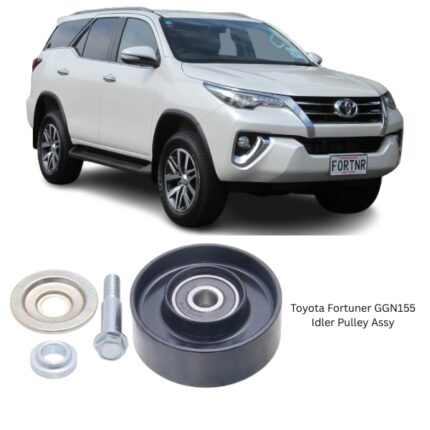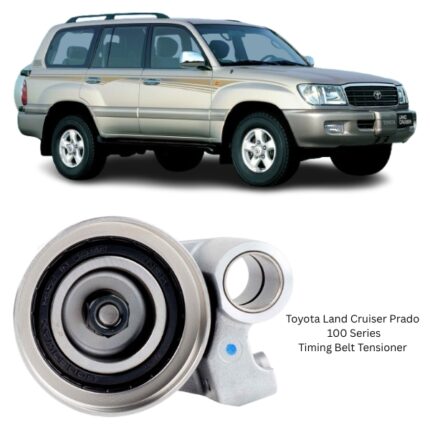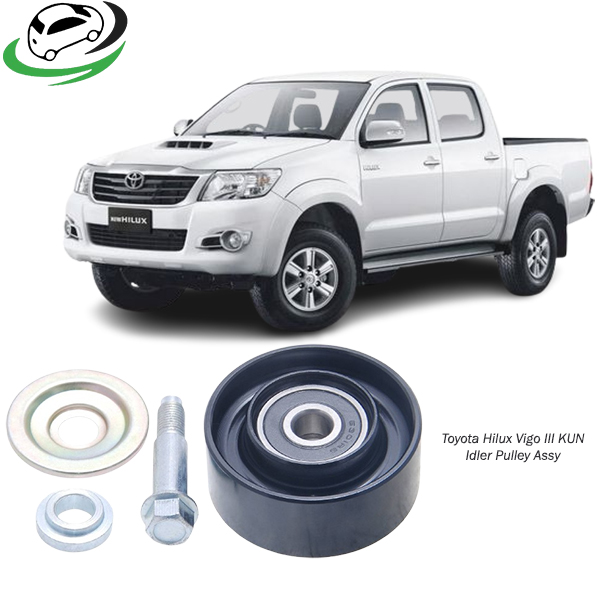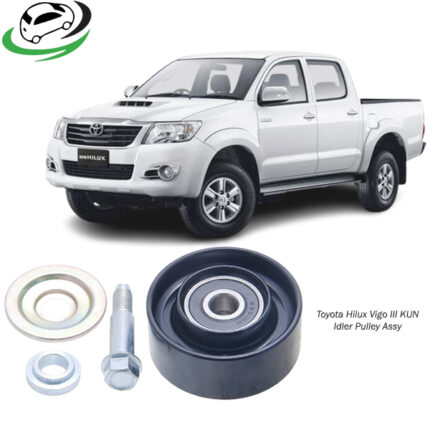Get Toyota Hilux Vigo III KUN Pulley Tensioner Kit Assy 0187-KUN25
The pulley tensioner kit assembly is a vital component in modern internal combustion engines. Its primary role is to maintain the correct tension on the drive belts, which are responsible for transferring power from the crankshaft to various engine accessories, such as the alternator, power steering pump, air conditioning compressor, and water pump. The proper tension of the drive belt is critical for the smooth functioning of these accessories, and the tensioner assembly ensures that the belt remains taut and free of slippage.
This comprehensive guide provides an in-depth explanation of the pulley tensioner kit assembly, including its structure, functions, types, common problems, maintenance tips, and replacement procedures.
1. Structure of the Pulley Tensioner Kit Assembly
The pulley tensioner kit assembly typically consists of the following components:
- Tensioner Pulley: The pulley that comes into direct contact with the serpentine or timing belt. It has a smooth or grooved surface to maintain proper belt tracking and tension.
- Tensioner Arm: This arm holds the pulley and allows it to pivot as the belt moves. The arm can move slightly to adjust the tension on the belt as it expands and contracts due to engine temperature changes.
- Spring Mechanism: The spring inside the tensioner assembly applies constant pressure to the tensioner arm, ensuring that the belt remains tight throughout its operation.
- Bracket or Mounting Assembly: This part secures the tensioner to the engine block or a specific mounting point, providing stability and correct alignment.
- Hardware (Bolts and Fasteners): The tensioner kit typically comes with bolts, washers, and other fasteners needed to install the tensioner assembly securely.
2. Function of the Pulley Tensioner Kit Assembly
The pulley tensioner assembly plays several critical roles in an engine’s accessory drive system. These functions include:
- Maintaining Belt Tension: The primary function of the tensioner is to keep the drive belt under proper tension. A loose belt can slip off the pulleys or fail to transmit power effectively, while an overly tight belt can cause excessive wear on both the belt and engine accessories. The tensioner ensures the belt remains at the ideal tension.
- Absorbing Vibrations: During engine operation, the serpentine or timing belt experiences fluctuations in tension due to changes in load or engine speed. The tensioner absorbs these vibrations and movements, preventing excessive wear on the belt and other components.
- Compensating for Belt Stretch: Over time, drive belts stretch due to heat, friction, and normal wear. The tensioner assembly automatically compensates for this stretch by adjusting the tension on the belt, extending the life of both the belt and the engine’s accessories.
- Preventing Belt Slippage: A loose or misaligned belt can slip off the pulleys, leading to a loss of power to critical components such as the alternator or water pump. The tensioner ensures the belt remains firmly in place, even as the engine runs at varying speeds.
- Protecting Engine Accessories: The tensioner helps protect the engine’s accessories from unnecessary strain caused by improper belt tension. For example, if the belt is too loose, the alternator may not function properly, resulting in electrical issues. If it’s too tight, it can damage the bearings in components like the water pump or power steering pump.
3. Types of Pulley Tensioners
There are different types of pulley tensioners, each designed to work with specific engine configurations and belt systems:
- Automatic Tensioners: Most modern vehicles use automatic tensioners, which are spring-loaded devices that automatically adjust to maintain the correct belt tension as the belt stretches or contracts. These are the most common type of tensioner in modern cars and require minimal maintenance.
- Manual Tensioners: In some older vehicles, manual tensioners are used. These require manual adjustment to set the proper belt tension. While these are less common today, they were used in older engines before the advent of automatic tensioners.
- Hydraulic Tensioners: In some high-performance or heavy-duty engines, hydraulic tensioners are used. These use hydraulic pressure to maintain belt tension and provide superior damping of belt vibrations compared to spring-loaded tensioners.
- Serpentine Belt Tensioners: These tensioners are used in systems with serpentine belts, which drive multiple accessories with a single belt. The tensioner plays a crucial role in ensuring that the belt wraps tightly around each pulley, providing enough grip to drive all components efficiently.
- Timing Belt Tensioners: In engines that use timing belts (as opposed to chains), a tensioner is required to keep the belt in place and maintain proper timing between the camshaft and crankshaft. Timing belt tensioners are designed to provide very precise tension to avoid timing errors that could cause engine damage.
4. Common Issues with Pulley Tensioner Assemblies
Like all mechanical components, pulley tensioners can wear out over time. Some common problems associated with pulley tensioner assemblies include:
- Worn Bearings: The bearing inside the tensioner pulley can wear out due to friction, causing a squealing or grinding noise. If the bearing seizes, the pulley may stop turning, which can cause the belt to break or slip off the pulleys.
- Weak or Broken Spring: The spring inside the tensioner assembly can weaken over time, reducing its ability to maintain proper belt tension. In some cases, the spring may break entirely, requiring the replacement of the tensioner.
- Pulley Misalignment: If the tensioner arm or bracket becomes bent or damaged, the pulley can become misaligned with the drive belt. This can cause the belt to wear unevenly or slip off the pulleys.
- Cracked or Damaged Pulley: The pulley itself can crack or become damaged due to wear, extreme temperatures, or physical impact. A damaged pulley can cause excessive wear on the belt or lead to belt failure.
- Excessive Belt Vibration: If the tensioner assembly is worn or faulty, the belt may vibrate excessively during operation. This can cause premature wear on the belt and other components, leading to a shorter lifespan for the drive system.
5. Signs of a Failing Pulley Tensioner
It is important to recognize the signs of a failing tensioner to prevent more significant problems from developing. Here are some common symptoms of a worn or failing pulley tensioner:
- Squealing or Chirping Noise: A high-pitched squealing or chirping noise when the engine is running is a common sign of a worn or damaged tensioner. This noise often indicates that the tensioner pulley is not rotating smoothly or that the belt is slipping due to improper tension.
- Belt Slippage: If the belt appears loose or slips off the pulleys, it may indicate that the tensioner is no longer maintaining proper belt tension. This can lead to the failure of engine accessories like the alternator or power steering pump.
- Visible Wear on the Belt: If the belt shows signs of uneven wear, such as fraying, cracking, or glazing, it could indicate that the tensioner is not maintaining proper alignment or tension.
- Excessive Belt Vibration: A tensioner that has lost its ability to absorb vibrations can cause the belt to vibrate excessively. This can lead to premature wear on the belt and other components.
- Check Engine Light: In some cases, a failing tensioner can trigger the check engine light, especially if it causes the alternator or water pump to stop functioning properly.
6. Maintenance Tips for Pulley Tensioner Assemblies
While the pulley tensioner assembly is generally a low-maintenance component, regular inspections can help prolong its lifespan and prevent potential issues:
- Inspect Regularly: During routine maintenance, inspect the tensioner for any signs of wear or damage, such as cracks, misalignment, or unusual noise.
- Check Belt Condition: Since the tensioner works in tandem with the drive belt, it’s important to regularly check the condition of the belt. If the belt is worn or damaged, it can affect the performance of the tensioner.
- Listen for Unusual Noises: Pay attention to any squealing, chirping, or grinding noises coming from the engine, as these can indicate a problem with the tensioner or the belt.
- Replace When Necessary: If the tensioner shows signs of wear, such as a weakened spring, noisy bearing, or cracked pulley, it’s important to replace it promptly to prevent further damage to the belt and engine accessories.
7. Replacement Procedure for Pulley Tensioner Assemblies
Replacing a pulley tensioner assembly is a relatively straightforward process that can be performed by a skilled DIYer or professional mechanic. Here’s a general guide for replacing the assembly:
- Prepare the Vehicle: Park the vehicle on a flat surface and engage the parking brake. Disconnect the battery to prevent electrical shorts while working on the engine.
- Release Belt Tension: Use a wrench or ratchet to release tension on the drive belt by turning the tensioner. Once the tension is released, carefully remove the belt from the pulleys.
- Remove the Old Tensioner: Using the appropriate socket, remove the bolts securing the tensioner assembly to the engine block. Carefully slide the tensioner off the mounting bracket.
- Install the New Tensioner: Position the new tensioner assembly on the bracket and secure it with the bolts. Ensure that the pulley is properly aligned and spins freely.
- Reinstall the Belt: Carefully route the drive belt back over the pulleys, ensuring that it is properly aligned. Use the wrench or ratchet to apply tension to the belt by turning the tensioner.
- Double-Check the Installation: Once the belt is installed, visually inspect the alignment and tension. Start the engine and listen for any unusual noises that might indicate a problem.
In conclusion, the pulley tensioner kit assembly is a crucial component that helps ensure the smooth operation of the engine’s accessory systems. Proper maintenance and timely replacement of this component can prevent costly repairs and keep your engine running efficiently.
Follow us on Facebook for more parts.





Reviews
Clear filtersThere are no reviews yet.